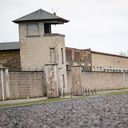Extreme weather and vandalism threatening Holocaust sites

Extreme weather events worsened by climate change are chipping away at sites linked to the Holocaust and endangering historical buildings, archives and artifacts, according to an international advocacy group.
The big picture: Mass graves and sites of former concentration camps hold the record of the Holocaust. As the last generation of the Holocaust ages, these sites are the final living memory of what happened.
What's happening: In recent years, floods and harsh storms have caused severe damage to buildings in the former ghetto of Terezin in the Czech Republic, the International Holocaust Remembrance Alliance (IHRA) said.
- Severe weather was also responsible for the destruction of large segments of the perimeter wall of the former concentration camp at Sachsenhausen in Germany.
- Flood waters were so high at the former subcamp of Gusen in Austria that waters entered the crematorium, causing damage.
- Floods also threaten mass graves at the subcamp of Ustica in Croatia.
Zoom out: The new IHRA Charter for Safeguarding Sites has identified 16 threats to Holocaust heritage in the 21st century, with climate change and vandalism topping the list.
- Many of the sites are at least 80 years old.

What they're saying: "With climate change, we cannot turn back the clock. We can only try to limit damage," Gilly Carr, a member of the U.K. delegation of IHRA, tells Axios.
- Carr said sites don't necessarily need restoration but possibly "making them more climate-resilient."
- "All we can do is to consider why Holocaust sites are significant to communities ... and to find ways to safeguard the significance, even if the historic fabric is damaged."
State of play: Antisemitism and white nationalism have risen on the political landscape in several countries — including the U.S.
- The demise of Holocaust sites could aid in misinformation about real atrocities.
Between the lines: Preserving sites of genocide has always been a hotly debated topic in communities affected by trauma.
- The Taos Pueblo in New Mexico, for example, keeps on display the ruins of Mission San Geronimo, which was cannonballed by the U.S. forces in an attack that killed Mexicans and Native Americans who took refuge there during an 1847 rebellion.
- The tribe has said it will not restore the ruins once the weather finally destroys them.
- Oglala Sioux Tribe bought the Wounded Knee National Historic Landmark site in 2022 after years of legal fights.
What's next: The IHRA Charter for Safeguarding Sites is providing nations and local communities with proposals on protecting sites from climate change-related impacts.
- Ideas include maintaining an inventory, digitizing all data and consulting with outside groups on ways to safeguard sites.